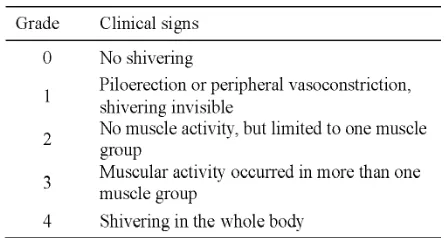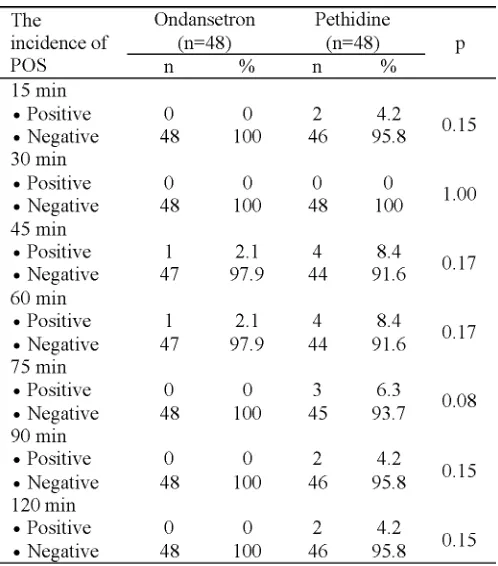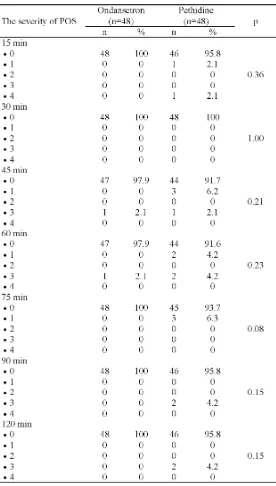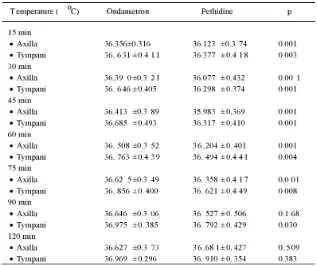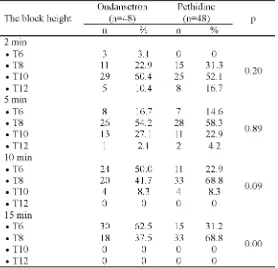* corresponding author: [email protected]
The efficacy of ondansetron in comparison
with pethidine for prevention of shivering in
pregnant patients undergoing a cesarean
section with spinal anesthesia
Ferianto1, Pandit S2, Bambang Suryono S2
Dumai District Hospital, Riau,2Department of Anesthesiology and Reanimation, Faculty
of Medicine, Universitas Gadjah Mada University/Dr. Sardjito General Hospital Yogyakarta
ABSTRACT
Postanesthetic shivering (POS) is a common complication following spinal anesthesia. Several drugs have been used to prevent POS, including ondansetron and pethidine. This study was conducted to compare the efficacy of ondansetron 8 mg with pethidine 0.4 mg/kg BW for prevention of shivering in pregnant patients undergoing a cesarean section with spinal anesthesia. This is a double blind controlled trial involving 96 pregnant patients between the age 18-40 years with ASA physical status I-II, gestational age of 37-42 weeks, body weight of 40-70kg or Body Mass Index (BMI) <30, body height >145 cm who underwent a cesarean section with spinal anesthesia in Dr. Sardjito General Hospital, Yogyakarta and affiliated hospital. Exclusion criteria included patients or families who refused to participate in the study, having a history of allergy to bupivacaine, ondansetron, and pethidin, patients with a fetus known to have congenital abnormalities earlier, body temperature early > 38 ºC or <36 ºC, pregnancy with complications (PEB, eclampsia, HELLP syndrome), and pregnant patients with heart disease (severe hypertension, heart trouble, abnormal heart valves). The patients were randomized into two groups i.e. 48 patients of group ondansentron receiving intravenous ondansetron 8 mg and 48 patients of group pethidine receiving intravenous pethidine 0.4 mg/kg BW. The patients were observed for occurence and severity of POS, postoperative nausea and vomiting. The results showed that two patients (4.2%) on the ondansetron group and six patients (12.5%) on the pethidine group experienced of POS. Moreover, the efficacy of ondansetron in the prevention of POS (95.8%) was higher than pethidine (87.5%). However, there were not significantly different (p>0.05). The incidence of nausea on the ondansetron group (4.2%) was lower than the pethidine group (16.7%) (p<0.05). However, no significant difference in the incidences of vomiting was observed between the ondansetron (0%) dan the pethidine (4.2%) groups (p>0.05). In conclusion, the efficacy of ondansetron 8 mg is comparable to pethidine 0.4 mg/kgBW for prevention of shivering in pregnant patients after spinal anesthesia.
ABSTRAK
pasien dengan janin diketahui mempunyai kelainan kongenital sebelumnya, temperatur awal >38oC atau <36 oC, kehamilan dengan komplikasi (PEB, eklamsia dan simdrom HELLP), dan pasien hamil dengan kelainan jantung (hipertensi berat, gangguan jantung, kelainan denyut jantung). Pasien diacak menjadi dua kelompok yaitu 48 psien kelompok ondansetron yang menerima ondanstron 8 mg intravena dan 48 pasien kelompok petidin 0.4 mg/kg BB intravena. Pengamatan dilakukan terhadap kejadian dan keparahan POS, mual dan mutah pasca operasi. Hasil penelitian menunjukkan dua pasien (4,2%) pada kelompok ondansetron dan enam (12,5%) pada kelompok petidin mengalami POS. Efikasi ondansetron dalam mencegah POS (95.8%) lebih tinggi dari petidin (87,5%). Namun demikian tidak terdapat perbedaan nyata (p>0,05). Kejadian mual pada kelompok ondansetron (4,2%) lebih rendah dari pada kelompok petidin (16.7%) (p<0,05). Namun demikian kejadian mutah tidak berbeda nyata pada kelompok ondansetron (0%) dan petidin (4,2%) (p>0,05). Dapat disimpulkan, efikasi ondansetron 8 mg sebanding dengan petidin 0,4 mg/kg BB untuk mencegah shivering pada psien hamil setelah tindakan anestesi spinal.
Key words: shivering - hypothermia - spinal anesthesia - ondansetron - pethidine
INTRODUCTION
Postanesthetic shivering (POS) is an involuntary movement that may affect one or several muscle groups. Postanesthetic shivering is a common complication following general anesthesia and also occurs intraoperatively during moderate and deep sedation.1-3 The incidence of POS is reported between 5 up to 60% of patients recovering from general anesthesia and up to 30% of patients receiving epidural anesthesia.4,5 Age, gender, type of anesthesia, amount and temperature of intravenous fluids, duration of surgery and temperature of operating room seem to be determinant factors of POS.1-5
The body thermoregulatory system coordinates defense against temperature changes to maintain body temperature within a normal range by optimizing normal body function. The central thermoregulatory control is the hypothalamus. Spinal anesthesia induces thermoregulatory impairment and leads to hypothermia. The hypothermia results from redistribution of body heat to periphery. Normally, heat loss is regulated by cutaneous vasodilation or vasoconstriction, sweating, and shivering. Shivering is an important complicat-ion of hypothermia. Shivering is a last defense
that is activated only when behavioral compensations and maximal arterio venous shunt vasoconstriction are insufficient to maintain body temperature.1-3It is an involun-tary, oscillatory muscular activity that augment metabolic heat production up to 600% above basal level.6,7
The first clinical consequence of POS is the discomfort for the patients. Moreover, it is associated with number of deleterious of sequelae. These include increased oxygen consumption and carbon dioxide production, cathecolamine release, a significant increased metabolic acidosis, increased cardiac output, tachycardia and hypertension, raised intraocular and intracranial pressures, increased risk of incidental trauma, and disrupts medical devices.6-8 Postanesthetic shivering may also decrease mix venous oxygen saturation as well as interfering with electrocardiogram and pulse oxymetri monitoring.9,10
prevention and treatment of shivering in the majority of adults. Pethidine has long been used as standard therapy to prevent and treat shivering postanesthetic action.5-7
Postanesthetic shivering is accosiated with stimulation of seretonin or 5-hydroxytryptamine (5-HT) receptor in the brain and spinal cord. The 5-HT receptor plays an important role in control of the heat production and loss of body heat.14Antagonist of 5-HT
3such as ondanstron and granisetron is reported to have effect against POS.14-16 Moreover, ondansetron has been shown to be effective in the prevention of post-operative nausea and vomiting (PONV).17An agent to reduce both POS and PONV will be very benefit.18This study was conducted to evaluate the efficacy of intravenous bolus of ondansetron 8 mg in comparison to intravenous bolus of pethidine 0.4 mg/kg BW for prevention of shivering in pregnant patients undergoing a cesarean section with spinal anesthesia.
MATERIALS AND METHODS
Subjects
This was a randomized double-blind clinical trial conducted after approval from the Medical and Health Research Ethic Committee, Faculty of Medicine, Universitas Gadjah Mada, Yogyakarta and obtaining a written informed consent. A total of 96 pregnant women patients between the age 18-40 years with ASA physical status I-II, gestational age of 37-42 weeks, body weight of 40-70kg or Body Mass Index (BMI) <30, body height >145 cm who underwent a cesarean section with spinal anesthesia techniques in Dr. Sardjito General Hospital, Yogyakarta and affiliated hospital i.e. Dr. Soeradji General Hospital, Klaten, Central Java, Banyumas General Hospital, Central Java and Panembahan Senopati District Hospital, Bantul, Yogyakarta for period of February to June 2011. Exclusion criteria included patients or families
who refused to participate in the study, having a history of allergy to bupivacaine, ondansetron, and pethidin, patients with a fetus known to have congenital abnormalities earlier, body temperature early > 38 ºC or <36 ºC, pregnancy with complications (PEB, eclampsia, HELLP syndrome), and pregnant patients with heart disease (severe hypertension, heart trouble, abnormal heart valves). Drop out criteria included patients experienced total spinal, sensory and motor block (T4-T8) not happened 15 minutes after anesthesia, spinal anesthesia considered fail, withdrew from the research and bleeding complications (uterine atony). The patients were randomly allocated to one of two groups i.e. 48 patients of group ondansentron receiving 8 mg ondansetron as an intravenous bolus injection and 48 patients of group pethidine receiving pethidine 0.4 mg/kg BW as an intravenous bolus injection.
Protocol of study
8 mg ondansetron or pethidine 0.4 mg/kg BW was given as an intravenous bolus injection. The patients were placed in sitting or lateral dicubitus position and the spinal anesthesia was performed at the L3-4 lumbar region puncturing with a 25 G needle under sterile technique. Local anesthesia was conducted using 12.5 mg of 0.5% hyperbaric bupivacaine. The patients were then placed in the modified supine position with a pillow. The level of sensory blockade was evaluated using pinprick method at the second minute after spinal induction and continued in five-minute interval for 15 minutes. Standards for patient hemodynamic monitoring during anesthesia i.e. MAP, PR and RR was performed in five-minute interval for the first 15 minutes and then in fifteen-minute interval from the time just after the anesthesia started to
the end of the operation. Oxygen
supplementation was given using nasal cannulae. In the case of hypotention or blood pressure dropped >20%, 5-20 mg of ephedrine was given as an intravenous bolus injection. The patients were observed for occurence and severity of POS, postoperative nausea and vomiting, axilla and tympanic membrane temperature in fifteen-minute interval from the time just after anesthesia strated to the end of the operation and then thirty-minute interval from the end of the operation to the patients were placed in the recovery room. An intravenous bolus injection of pethidine 25 mg was given to patients with shivering. Moreover, intravenous of analgesic ketorolac 30 mg was given before the end of the operation. The severity of POS was measured as conducted by Crossley and Mahajan19with the criteria presented in TABLE
1. Data were recorded on the predesigned data collection form.
Statistical analysis
Data were tabulated and presented as mean ± standard deviation (SD) or percent. Data of incidence and severity of shivering and the side effects of drugs of ondansetron and pethidine groups were analyzed statistically using Chi square test. Data of age, weight, hemodynamic chages, axilla and tympanic membarane temperatures, operation room temperature were analyzed statistically using independent t-test. A p value <0.05 was considerd statistically significant. All statistic analysis was performed using SPSS version 15 computer program.
RESULTS
Forty eigth patients were involved in each group of this study. The characteristics of patients of both groups are presented in TABLE 2. No significant difference was observed in terms of age, weight, height, BMI, systolic and diastolic blood pressure, MAP, HR, RR, axilla and tympani temperatures, and room temperature between the groups (p>0.05). It was indicated that the patients characteristics of both groups were comparable.
TABLE 2. Characteristics of subjects (mean ± SD or percent) of ondansetron and pethidine groups
The incidences of POS at different time intervals on the group of ondansetron and the group of pethidine are presented in TABLE 3, while the severity of POS are presented in
TBALE 4. No significant difference in the incidences and the severity of POS between the two gropus was also also observed (p>0.05).
TABLE 4. The severity of POS at different time intervals on ondansetron and pethidine groups
The patients who experienced of POS on the group of ondansetron and pethidine are presented in TABLE 5. Two patients (4.2%) on the group of ondansetron and 6 patients (12.5%) experienced of POS. Moreover, the effectivenss
TABLE 5. The patients who experienced of POS on ondansetron and pethidine groups
The axilla and tympani temperatures after spinal anesthesia at different time intervals on the group of ondansetron and the group of pethidine are presented in TABLE 6. The axilla temperature of patients on the group of ondansetron in the 15; 30; 45; 60 dan 75 minutes after spinal anesthesia was normally significantly higher than the group of pethidine (p<0.05), while in the 90 and 120 minute was
not significantly different (p>0.05). Further-more, the tympani termperature of patients on the group of ondansetron at different time intervals of observation was normally significantly higher than the group of pethidine (p<0.05), except in the 120 minute. No significant difference of the tympani temperature was observed in the 120 minute after spinal anesthesia on the both groups (p>0.05).
TABLE 6. The body temperature at different time intervals on ondansetron
The block heights after spinal anesthesia at different time intervals on the group of ondansetron and the group of pethidine are presented in TABLE 7. The block heigths in the minute 2 and 5 on the group of ondansetron was
not significantly different compared to the group of pethidine (p>0.05). However, the block height on the group of ondansetron in the minute 10 and 15 was significantly different compared to the group of pethidine (p<0.05).
TABLE 7. The block heights after spinal anesthesia at different time
intervals on on ondansetron and pethidine groups
The incidence of side effects of drugs i.e. nausea and vomiting after spinal anesthesia on ondanstron and pethidine groups are presented in TABLE 8. The incidence of nausea on the ondansetron group (4.2%) was lower than the
pethidine group (16.7%) (p<0.05). No significant difference in the incidences vomiting was observed between the ondansetron (0%) dan the pethidine groups (4.2%) (p>0.05).
TABLE 8. The incidence of nausea and vomiting on ondansetron and
pethidine groups
The incidence of shivering on patients who had history of misoprostol administration on the ondanstron and the pethidine groups is presented in TABLE 9. No significant difference in the incidence of shivering on patients who had history of misoprostol administration was observed between both groups (p>0.05). Among 8 patients who experienced shivering, just 1
(12.5%) patient having history of misoprostol administration, while 7 (87.5%) patients not having of history of mistoprostol administration, whereas from 88 patients who not experienced shivering, there just 9 (10.2%) patients having history of mistoprostol administration, whereas 79 (89.8%) not having of histroy of mistoprostol administration.
TABLE 9. The incidence of shivering on patients who had history of
misoprostol administration on ondansetron and the pethidine groups
The length of operation, fluid administrat-ion, and bleeding during spinal anesthesis on the ondansetron and the phetidine groups are presented in TABLE 10. No significant different
in the length of operation, fluid administration, and bleeding were observed between the both groups (p>0.05).
TABLE 10. Length of operation, fluid administration, and bleeding (mean ± SD) during spinal
anesthesis on the ondansetron and the phetidine groups.
DISCUSSION
Ondansetron is a 5-HT3antagonist that it is indicated to prevent nausea and vomiting.17In addition, ondansetron is useful for prevention of shivering in patients undergoing spinal anesthesia, regional anesthesia and pain medicine.16In this study we reported the efficacy of intravenous bolus of ondansetron 8 mg in comparison to intravenous bolus of pethidine
degree 1 to degree 4. Pethidine 25 mg intravenouly was given to patients who suffering from POS at degree 3 and 4.
Normally, the incidence of POS was observed at 45, 60 and 75 minutes time intervals, although at 15, 90 and 120 mintues time interval, the incidence of POS was also observed (TABLE 4). It is reported that the incidence of POS occurs noramlly at 0.5 to 1 hour after patients undergoing spinal anesthesia. During temperature measurement, the axillary temperature decreases significantly in the minute 15 until the minute 75, while the tympanic temperature decreases significanlty in the minute 15 untul the minute 90. The axillary and tympanic temperatures are generally tounght to be the most accurate for checking a body temperature. The decrease of axillary and tympanic temperatures reflecting the decrease of the body temperature or hypotermia leads to the POS as a compensation of the body to increase heat production. Kelsaka16and Powel and Buggy20 reported that patients who underwent spinal or epidural anesthesia can not maintain the central temperature due to impaired peripheral vasoconstriction. In addition, the patients who underwent spinal anesthesia produce relatively little heat due to only small part of the muscles that contract i.e. just part of the blocked chepalad.
Among 48 patients who underwent the cesarean section with spinal anesthesia in the ondansetron group, only two patients (4.2%) suffer POS indicating that its effectiveness in reducing of POS is 95.8%. While in pethidine group, among 48 patients who underwent the cesarean section, six patients (12.5%) suffer POS indicating that its effectiveness is 87.5%. The effectiveness of ondansetron in reducing of POS has been reported by some authors varying from 84 to 92%16,20,21 while the effectiveness of pethidine varied from 84 to 90%.14,21,22
The side effects of drugs including nausea and vomiting were observed in this study. The incidence of nausea on ondansetron group (4.2%) was significantly lower than pethidine group (16.7%) (p<0.05). Moreover, the incidence of vomiting was just observed on pethidine group (4.2%) although it was not significantly difference compare to ondansetron group (p>0.05). This study was in accordance with the previous studies indicating that the side effects of nausea and vomiting were lower on the ondansetron group compare to pethidine group.16 The higher incidence of nausea and vomiting on pethidine group was caused by its stimuli effect directly on the vomiting center in the chemoreceptor trigger zone. In contrast, ondansetron is an antagonist of 5-HT3that it is indicated to prevent nausea and vomiting.17The results of this study support the previous study indicating that ondansetron can reduce both POS and PONV.17,18
The disadvantage of ondansetron to prevent POS has been indicated. Ondansetron is related to the incidence of heart rhythm disorders such as arrythmias. The incidence of arrhytmias due to ondansetron has been reported in the previous studies although it is relatively rare. Moreover, ondansetron has a wide dosage range with the maximum doses of 100 mg/day therefore ondansetrone is relatively safe. The side effect of arrhytmias due to ondansetron is normally suffered patients who a history of QT prolongation or QT syndrome with electrolyte disturbances and severe hepatic function. Therefore, Food and Drug Administration (FDA) USA is not recommended ondansetron for these patients.16,23,24
shivering that it is accociated with dose and time administration. The side effect of shivering appears after 2-6 hours misoprostol administration in high dose.16,25,26
CONCLUSION
In conclusion, the efficacy of ondansetron 8 mg intravenous bolus is comparable to pethidine 0.4 mg/kgBW intravenous bolus for prevention of shivering in pregnant patients after spinal anesthesia. In addition, the incidence of nausea after ondansetron administration is significantly lower than after pethidine administration.
ACKNOWLEDGEMENTS
Authors would like to thank Head of Department ofAnesthesiology and Reanimation, Faculty of Medicine, Universitas Gadjah Mada/ Dr. Sardjito General Hospital for his permissi-on to cpermissi-onduct this study. We would also like to thank all subjects who have participated in this study.
REFERENCES
1. Alfonsi P. Postanesthetic shivering.
Epidemio-logy, patofisiology and approaches to prevention and management. Minerva Anestesio 2003; 69: 438-41
2. Barash PG, Cullen BF, Stoelting RK. Clinical
Anesthesia, 5th ed. Connecticut: Lippincott
Williams & Wilkins, 2006.
3. Díaz M. Becker DE. Thermoregulation:
physio-logical and clinical considerations during sedation and general anesthesia. Anesth Prog 2010; 57:25-33.
4. Mathews S, Al Mulla A, Varghese PK, Radim K,
Mumtaz S. Postanaesthetic shivering: A new look at tramadol. Anaesthesia 2002; 57: 394–8.
5. Zahedi H. Comparison of tramadol and pethidine
for postanesthetic shivering in elective cataract surgery. J Res Med Sci 2004; 5: 235–9.
6. Bhattacharya PK, Bhattacharya L, Jain RK,
Agarwal RC. Post anaesthesia shivering: A review. Indian J Anaesth 2003; 47 (2): 88-93.
7. Buggy DJ, Crossley AWA. Thermoregulation, mild
perioperative hypotermia and post anesthetic shivering. Br J Anaesth 2000; 84(5): 615-28.
8. Saha E, Ray M, Mukherjee G. Effect of tramadol
in prevention of postanaesthesia shivering following general anaesthesia for cholecyst-ectomy. Indian J Anaesth 2005; 49:208–12.
9. Morgan GE, Mikhail MS, Murray MJ. Clinical
anesthesiology. New York: Lange Medical Books/ McGraw Hill, 2006.
10. De Witte J, Sessler DI. Perioperative shivering: physiology and pharmacology. Anesthesiology 2002; 96: 467–84.
11. Dal D, Kose A, Honca M, Akinci SB, Basgul E, Aypar U. Efficacy of prophylactic ketamine in preventing postoperative shivering. Br J Anaesth 2005; 95: 189–92.
12. Tewari A, Katyal S, Singh A, Garg S, Kaul TK, Narula N. Prophylaxis with oral clonidine prevents perioperative shivering in patients undergoing transuretheral resection of prostate under subarchanoid blockade. Indian J Urol 2006; 22: 208–12.
13. Alfonsi P, Adam F, Passard A, Guignard B, Sessler DI, Chauvin M. Nefopam, a nonsedative benzoxazocine analgesic, selectively reduces the shivering threshold in unanesthetized subjects. Anesthesiology, 2004; 100: 37–43.
14. Iqbal A, Ahmed A, Rudra A, Wankhede RG,
Sengupta A, Das T, et al. 2009. Prophylactic
granisetron vs pethidine for the prevention of postoperative shivering: a randomized control trial. Indian J Anaesth 2009; 53(3): 330–4. 15. Joyce A, Dennis J. Ondansetron side of effect and
uses. Hospital Pharmacy 2009; 44(8): 670-1. 16. Kelsaka E. Comparison of ondansetron and
meperidine for prevention of shivering in patients undergoing spinal anesthesia, regional anesthesia and pain medicine. Cand J Anaest 2006; 31: 40-5. 17. Gardner C, Perren M. Inhibition of anesthetic-induced emesis by a NK1 or 5-HT3 receptor
antagonist in the hous musk shrew,Suncus
muri-nus. Neuropharmacology 1998; 37: 1643-4. 18. Entezariasl M, Khoshbaten M, Isazadehfar K,
Akhavanakbari G. Efficacy of metoclopramide and dexamethasone for postoperative nausea and vomiting: a double-blind clinical trial. East Mediterr Health J 2010; 16: 300-3.
20. Powel RM and Buggy DJ. Ondansetron given before induction of anesthesia reduces shivering after general anesthesia. Anesth Analg 2000; 90: 1423-7.
21. Asl ME, Isazadehfar Kh, Akhavanakbari G, Khoshbaten M. The effect of ondansetron in prevention of postoperative shivering after general anesthesia in gynecological surgery. Iran Red Crescent Med J 2012; 14(5): 316-7.
22. Parsa T, Dabir S, Radpay B. Efficacy of pethidine and buprenorphine for prevention and treatment of postanesthetic shivering. Tanaffos 2007; 6(3): 54-8.
23. US Food Drug Administration. FDA Drugs Safety Communication: Abnormal heart rhythms may be associated with use of Zofran (ondansetron). 2011. [Accessed Nov 6, 2011]. Available from: h t t p : / / w w w. f d a . g o v / d r u g s / d r u g s a f e t y / ucm271913.htm
24. Min J and Haddad T. Anesthesia for obstetric and
gynecology. In: Huford WE, et al., Eds. Clinical
anesthesia procedures of the Massachusetts General Hospital/Department of Anesthesia and Critical Care, Massachusetts General Hospital,
Harvard Medical School. 6thEds., Philadelphia:
Lippincott Williams & Wilkins, 2002.
25. Kranke P, Eberhart HL, Roewer N, and Tramer RM. Pharmacological treatment of postoperative shivering : a quantitative systematic review of randomized controlled trials. Anesth Analg 2002: 94: 453–60.
26. Komatsu R, Orhan-Sunur M, In J, Podranski T,
Bouillon T, Lauber R,et al. Ondansetron does not
